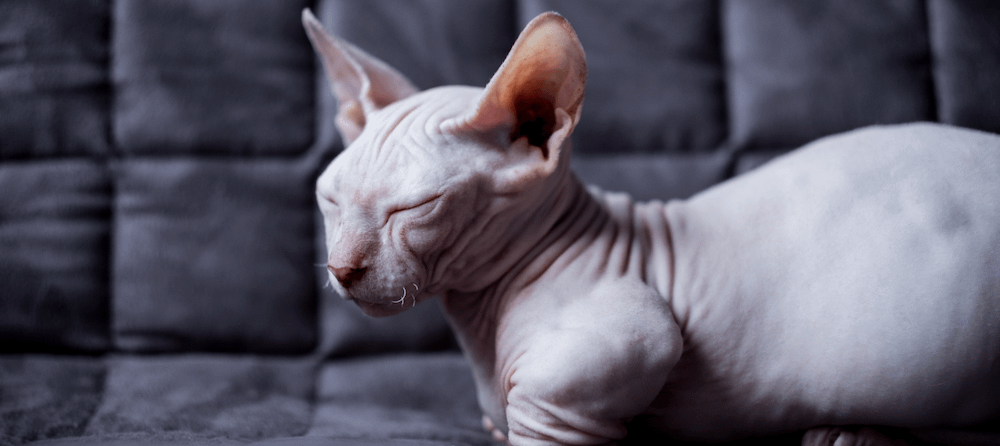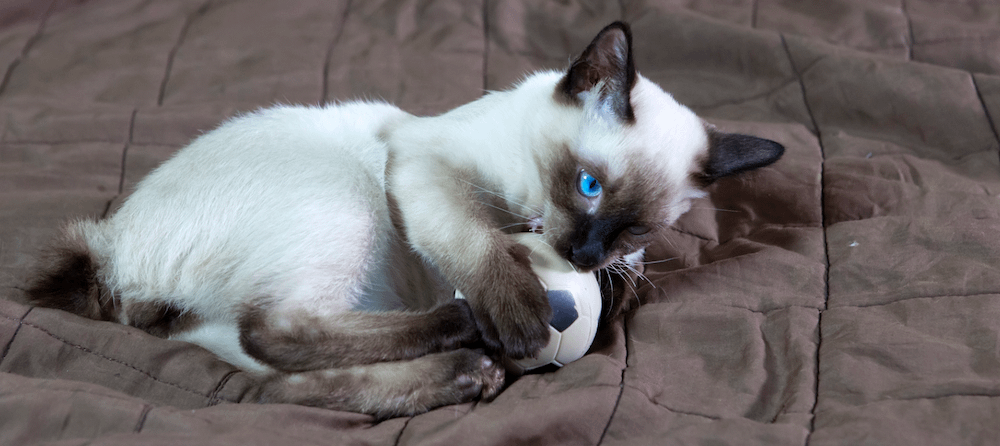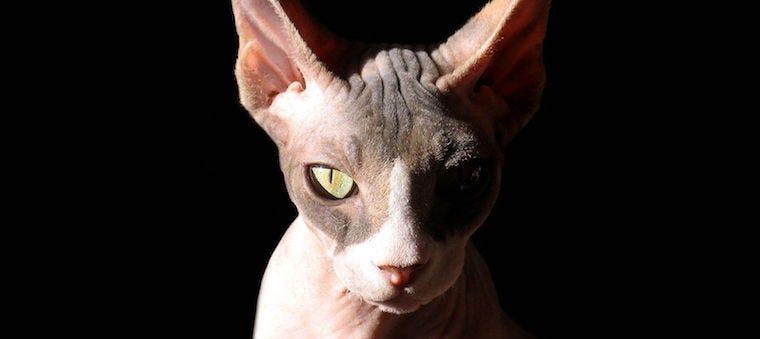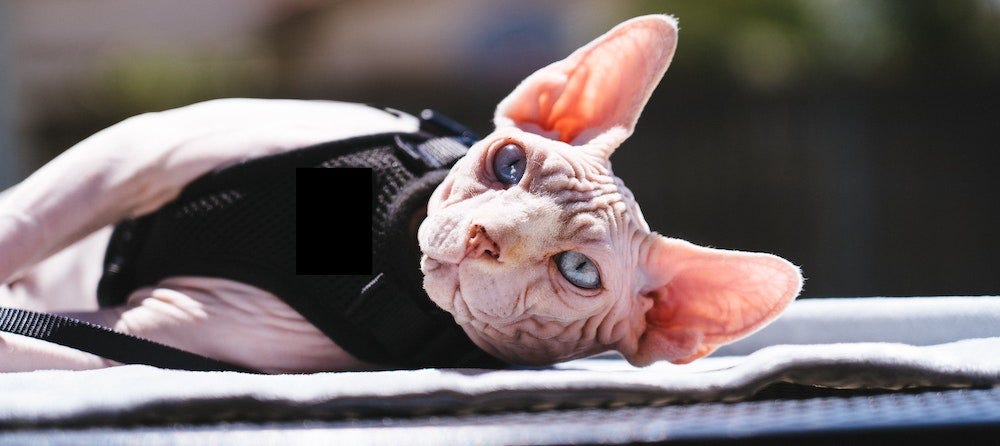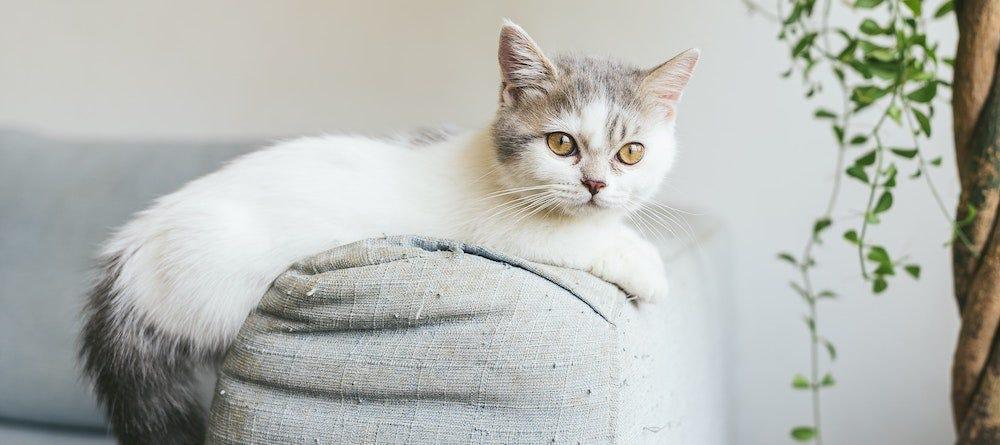The Bambino cat is a relatively new, relatively easy-to-spot breed with origins only dating back to 2005. These unique cats are recognized for their hairless appearance and short legs, meaning you might mistake them for miniature Sphynx cats. This double gene mutation makes them quite the rarity, being loved by all who come across them.
The name “Bambino” comes from the Italian word for “baby,” which is precisely how these little kitties are viewed. They love to be cared for and pampered, using their adorably small size to easily get what they want from their humans. Even if you have never seen this kind of cat before, you might be able to guess that they’re the genetic descendant of a Sphynx and Munchkin cat.
To learn more about these adorable little creatures, keep reading.
| Bambino cat | ...at a glance |
|---|---|
| Personality | Affectionate, friendly, playful |
| Life expectancy | 12-14 years |
| Weight | 5-9 lbs |
| Coat & colors | Hairless or peach fuzz; various pigmentations |
| Energy level | Medium |
| Affection level | High |
| Friendliness | High |
| Shedding level | Low |
| Required grooming | High |
Overview of the Bambino cat

Due to the Bambino being a newer breed, what we know about them is more surface level than anything; more information about the long-reaching effects of their genes will appear in time. They are quite the perfect combination of Sphynx and Munchkin cats, with adorably short legs and a unique hairless appearance. They are small-sized cats with a whole lot of spunk, making them very playful and entertaining feline friends to have in your home.
The Bambino may be a pocket-sized breed, but with their affectionate and outgoing personalities, small is only relative to their bodies.
Weight
Bambinos at full size usually weigh between 5 and 9 pounds. Males might be slightly larger than females, but for the most part, Bambinos are considered a small breed.
Though little and seemingly fragile, these cats don’t let their size get in the way of doing what they want. A Bambino can maintain their weight without much fluctuation because they are very active and energetic. As long as your Bambino gets enough playtime in, they can be happy and healthy.
Length
Bambino cats are very proportional in their size. They can reach up to 17 inches in length, which may seem quite long for their height and weight. Bambino cats have proportionate tails and bodies that suit them well.
Coat
The Bambino’s coat—or lack thereof—is extremely recognizable. These cats look almost identical to the Sphynx cat. It’s likely your Bambino will be mistaken for one until they begin their little waddle over to you.
While hairless, your Bambino could possibly have what resembles peach fuzz all along their body. They will be covered in deep wrinkles that seem somewhat loose on their bodies. The color of a Bambino varies, as well as their pattern. A Bambino can be solid, pointed, shaded, or bicolor, with colors ranging from black to cream to fawn.
Bambinos’ grooming requirements are considered high maintenance because this breed’s skin is very delicate and prone to injury and sunburns. Though these cats might not shed, they need extra diligent care to ensure they remain comfortable.
Life expectancy
Bambinos typically live 12 to 14 years when properly cared for. Due to the newness of the breed, there isn’t much known about what kind of genetic disorders and health-related issues may be passed down.
As a result of the uncertainty of this breed’s health and life expectancy, these cats are not meant for novice cat parents. Bambinos generally do better with people that have experience with cats in their households.
History of the Bambino cat
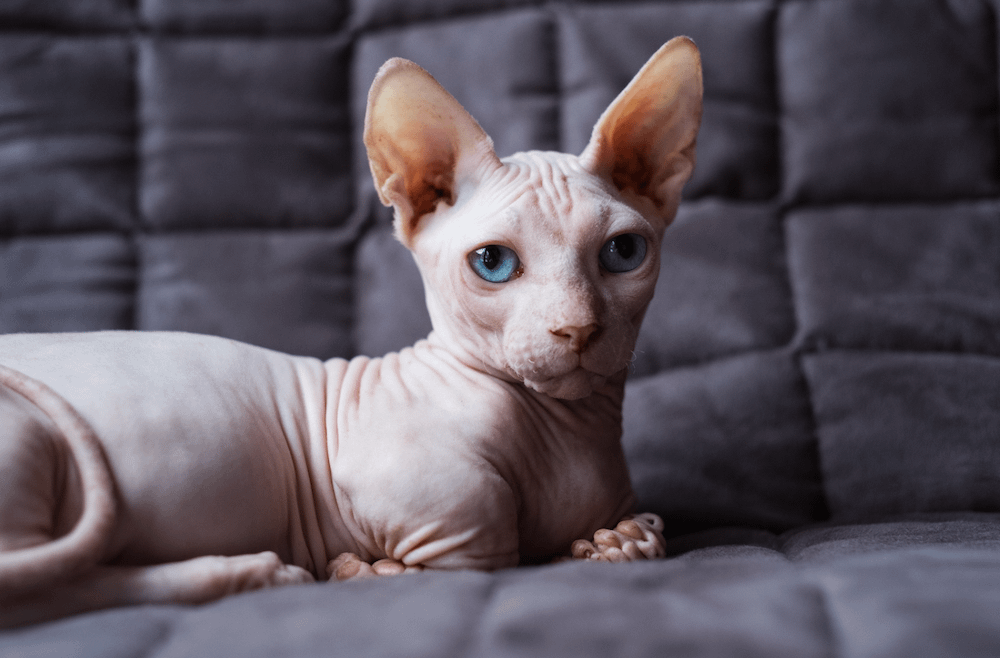
The Bambino cat breed did not exist before 2005, but that doesn’t mean a cat with similar features had never graced the world before. Both hairless coats and short legs are a genetic mutation that can spontaneously occur in any cat. It’s possible that a Sphynx cat was once born with shorter legs than their littermates, but up until 2005, this was never further developed.
Breeders Stephanie and Pat Osborne bred together Sphynx and Munchkin cats to promote the recessive hairless and short-legged genes. What came about was an adorable, short-legged, wrinkly cat with an outgoing, needy, and mischievous personality.
The International Cat Association (TICA) recognized that the Bambino was an experimental breed in 2006 but did not promote the combination of Sphynx and Munchkin cats to get these results. This has much to do with the unknown genetic health concerns that might come about due to this breed pairing.
Due to the rareness of this breed, you are highly unlikely to come across one on any given day. These cats might be popular due to their adorably unique looks, but they are not easy to find, whether from a reputable breeder or a cat rescue.
Bambino cat characteristics
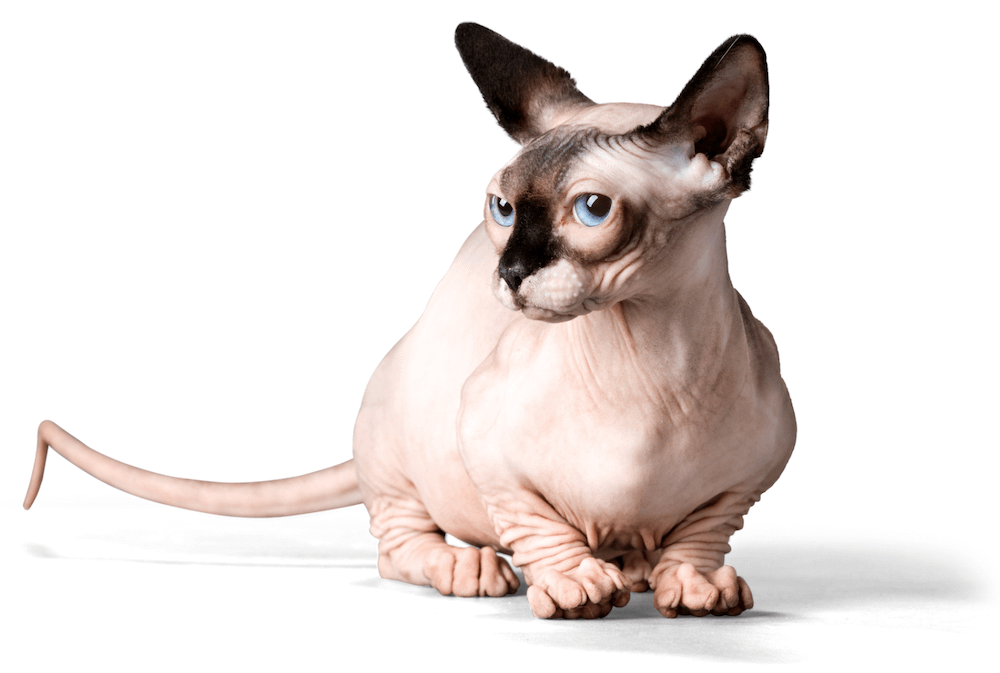
The two features that stand out when you see a Bambino are their short legs and hairless bodies.
They might look perpetually angry and annoyed with you with all of the little wrinkles that cover their entire body. They have striking blue eyes that are large and lemon-shaped. Their ears are tall and large, taking up most of their head, monitoring their surroundings almost 24/7.
While notably small, these cats should not be taken for granted, as they have loud personalities and aren’t afraid to take up space.
Personality and behavior
If you want a Velcro cat that prefers to spend time with you rather than chill alone, we introduce you to the Bambino. These lovable and outgoing cats prefer to be surrounded by family members so they don’t feel left out. They like to snuggle and want to be on a person’s warm lap, maybe even in a fuzzy sweater!
Bambinos love to play and will do so all day long if you stay engaged with them. They will go from toy to toy, and can even be taught to play fetch.
Bambinos love to climb and perch in sunny spots, as well as be involved in conversations happening around the house. They are vocal cats that will readily share their opinions (especially to tell you when they want more attention).
Like their Munchkin parent breed, these cats get along well with children who can respect and handle them properly. They also enjoy the company of other cats and animals. They are very adaptable and can live in apartments comfortably—what matters most is that their loved ones are around! Indeed, this breed will get lonely if away from their humans for too long.
Caring for a Bambino cat
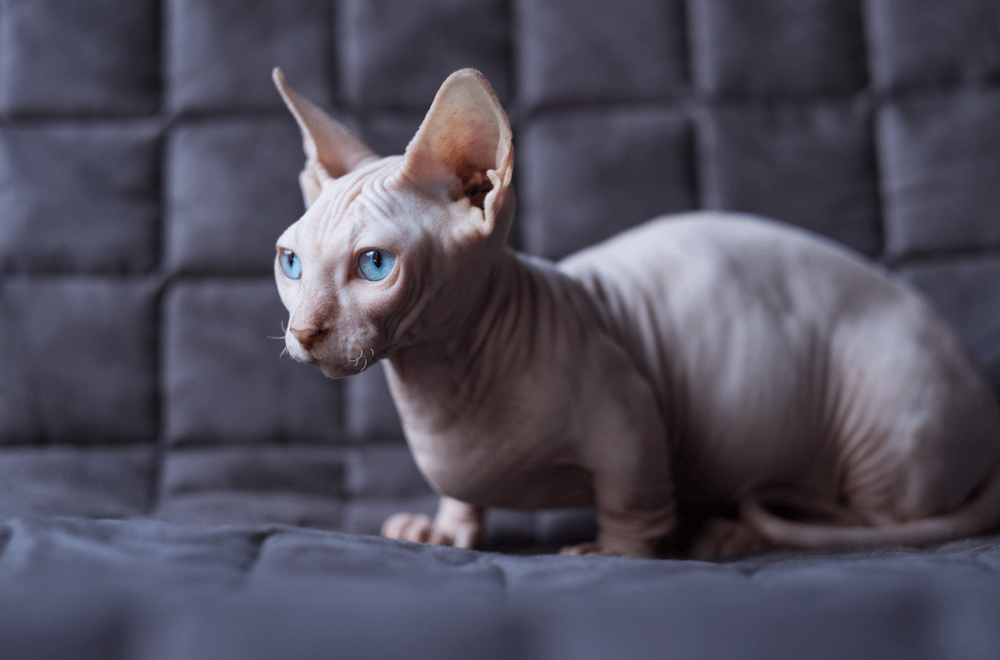
Bambinos are great cats, but they do require a lot of care. They have specific skin care needs that should be met in order to keep them healthy and comfortable.
They also have spunky personalities and high levels of energy, meaning you need to devote time each day to playing with your Bambino. If you aren’t someone with a lot of time on your hands, a Bambino might prove to be a lot of work.
Is the Bambino cat hypoallergenic?
While the Bambino doesn’t typically shed, they aren’t considered hypoallergenic. That’s because they, like all cats, produce the allergen-causing protein Fel d 1 in their dander, saliva, and urine.
Grooming
Bambinos might not have much fur on their bodies, but their grooming requirements can be extensive. Their skin is prone to becoming oily, which means they are at a higher risk for bacterial and fungal infections. Be sure to wipe down the oils and clean between the folds of a Bambino’s wrinkles to keep their skin clean. Regular bathing is vital, followed up by a nice warm towel to dry off in.
Be gentle with your Bamino’s skin, as it is highly sensitive. While they might want to sunbathe all day, they can easily get sunburned. Not only is this uncomfortable for your cat, but it can lead to skin cancer.
Feline best hygiene practices also include keeping their bathroom area clean (using a self-cleaning litter box helps here), scheduling regular nail trims, and cleaning their eyes, ears, and teeth from time to time.
Health-related issues
Since the Bambino is a new breed of cat, there aren’t specific health-related risks known or documented (other than skin infections from improper care). What is known comes from the health-related issues associated with Sphynx and Munchkin cats.
Two conditions seen in Munchkin cats that Bambinos could be at higher risk for are:
- Lordosis: When a cat's spine curves inward and puts pressure on vital organs.
- Pectus excavatum: When the breastbone caves in and causes respiratory problems, weight loss, and a general loss of appetite.
One condition seen in Sphynx cats that Bambinos might be at risk for is:
- Hereditary myopathy: When a cat’s muscles begin to weaken, making it more difficult for them to perform everyday tasks.
Taking home a Bambino
If you adopt a Bambino, just know that you are going to have the cutest, coolest, most unique pet out of all your friends. Everyone is going to want to meet your Bambino, and with proper introductions, your Bambino will be happy to be the center of attention.
Adopting a Bambino will introduce you to a new level of love, where you’ll be doing things that you never would’ve imagined you’d do for a cat. To love a Bambino is to make sure they are happy, warm, comfortable, exercised, and admired.
Sources:
- A structural UGDH variant associated with standard Munchkin cats | BMC Genomic Data
- Surgical Correction Of Pectus Excavatum In Two Cats | NCBI
- An update on molecular cat allergens: Fel d 1 and what else? Chapter 1 | BMC
- COLQ Variant Associated With Devon Rex And Sphynx Feline Hereditary Myopathy | NCBI
